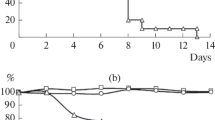Summary
Inoculation of hamsters with influenza virus [A/PR/8/34HON 1] produces an inapparent infection which can be monitored by virus titrations of nasal washes or of homogenates prepared from trachea or lung. Antibody can be detected in the serum within 7 days following virus inoculation. Hamsters previously infected were found to be resistant to challenge with the same virus. The utility of this model for evaluating anti-influenza drugs was demonstrated with two compounds. Calcium elenolate, a virucidal agent, reduced the virus titers of nasal washes when the drug was given as nose drops near the time of virus inoculation so as to affect high drug concentrations in the nasal passages. Virazole, an inhibitor of virus replication, reduced the virus titers of the nasal washes when multiple drug treatments were given as nose drops in an effort to provide drug during the time of virus replication. The model described may provide a useful means of evaluating potential antiviral drug candidates inasmuch as the drug can be delivered directly into the nasal passages in a non-fatal influenza infection in a convenient laboratory animal.
Similar content being viewed by others
References
Babiker, H. A., Rott, R.: Plaque formation by influenza viruses in monolayers of chick kidney cells. J. gen. Virol.3, 285–287 (1968).
Bucknall, R. A.: The continuing search for antiviral drugs. Adv. Pharmacol. Chemother.11, 295–319 (1973).
Chanock, R. M.: Control of acute mycoplasmal and viral respiratory tract diseases. Science169, 248–256 (1970).
Friedewald, W. F., Hook, E. W.: Influenza virus infection in the hamster. A study of inapparent virus infection and virus adaptation. J. exp. Med.88, 343–353 (1948).
Haff, R. F., Schriver, P. W., Engle, C. G., Stewart, R. C.: Pathogenesis of influenza in ferrets. I. Tissue and blood manifestations of disease. J. Immunol.96, 659–667 (1966).
Haff, R. F., Schriver, P. W., Stewart, R. C.: Pathogenesis of influenza in ferrets: nasal manifestations of disease. Brit. J. exp. Pathol.47, 435–444 (1966).
Huffman, J. H., Sidwell, R. W., Khare, G. P., Witkowski, J. T., Allen, L. B., Robins, R. K.:In vitro effect of 1-β-D-ribofuranosyl-1, 2, 4-triazole-3-carboxamide (Virazole, ICN 1229) on deoxyribonucleic acid and ribonucleic acid viruses. Antimicrob. Ag. Chemother.3, 235–241 (1973).
Jennings, R., Potter, C. W.: Enhanced response to influenza A vaccines in hamsters primed by prior heterotype influenza infection. Arch. ges. Virusforsch.42, 197–206 (1973).
Jennings, R., Brand, C. M., McLaren, C., Shepherd, L., Potter, C. W.: The immune response of hamsters to purified hemagglutinins and whole influenza virus vaccines following live influenza virus infection. Med. Microbiol. Immunol.160, 295–309 (1974).
Khare, G. P., Sidwell, R. W., Whitkowski, J. T., Simon, L. N., Robins, R. K.: Suppression by 1-β-D-ribofuranosyl-1, 2, 4-triazole-3-carboxamide (Virazole, ICN 1229) of influenza virus-induced infections in mice. Antimicrob. Ag. Chemother.3, 517–522 (1973).
Larin, N. M.: Cardinal problems in search for antiviral drugs. Chemotherapia12, 201–214 (1967).
McFadzean, J. A.: Advances in the chemotherapy of viral diseases. Adv. Pharmacol. Chemother.7, 309–331 (1969).
Mills, J., Chanock, R. M.: Temperature-sensitive mutants of influenza virus. I. Behavior in tissue culture and in experimental animals. J. inf. Dis.123, 145–157 (1971).
Pinto, C. A., Haff, R. F., Stewart, R. C.: Pathogenesis and recovery from respiratory syncytial and influenza infections in ferrets. Arch. ges. Virusforsch.26, 225–237 (1969).
Pinto, C. A., Haff, R. F.: Antiviral activity of cycloocytlamine hydrochloride in influenza virus-infected ferrets. Antimicrob. Ag. Chemother. 1968, 201–206 (1969).
Renis, H. E.: Antiviral studies with Kethoxal. Ann. N. Y. Acad. Sci.173, 527 to 535 (1970).
Renis, H. E.: Effect of poly I: C on experimental respiratory infection in hamsters. Appl. Microbiol.20, 821–824 (1970).
Renis, H. E.:In vitro antiviral activity of calcium elenolate. Antimicrob. Ag. Chemother. 1969, 167–172 (1970).
Renis, H. E.: Inactivation of myxoviruses by calcium elenolate. Antimicrob. Ag. Chemother.8, 194–199 (1975).
Robinson, R. Q., Dowdle, W. R.: Influenza viruses. In:Lennette, E. H., Schmidt, N. J. (eds.), Diagnostic Procedures for Viral and Rickettsial Infections, 420–428. New York: American Public Health Association, Inc. 1969.
Schiff, L. J.: Studies on the mechanism of influenza virus infection in hamster trachea organ cultures. Arch. ges. Virusforsch.44, 195–204 (1974).
Sidwell, R. W., Kare, G. P., Allen, L. B., Huffman, J. H., Witkowski, J. T., Simon, L. N., Robins, R. K.:In vitro andin vivo effect of 1-β-D-ribofuranosyl-1, 2, 4-triazole-3-carboxamide (Ribovirin) on types 1 and 3 parainfluenza virus infections. Chemotherapy21, 205–220 (1975).
Soret, M. G.: System for antiviral drug evaluation in hamsters infected with HA-1 virus. Antimicrob. Ag. Chemother. 1968, 220–224 (1969).
Soret, M. G.: Antiviral activity of calcium elenolate on parainfluenza infection of hamsters. Antimicrob. Ag. Chemother. 1969, 160–166 (1970).
Taylor, R. M., Parodi, A. S.: Use of hamster (Cricetus auratus) for the detection of influenza virus in throat washings. Proc. Soc. exp. Biol. Med.49, 105–108 (1942).
Author information
Authors and Affiliations
Additional information
With 1 Figure
Rights and permissions
About this article
Cite this article
Renis, H.E. Influenza virus infection of hamsters. A model for evaluating antiviral drugs. Archives of Virology 54, 85–93 (1977). https://doi.org/10.1007/BF01314381
Received:
Accepted:
Issue Date:
DOI: https://doi.org/10.1007/BF01314381




